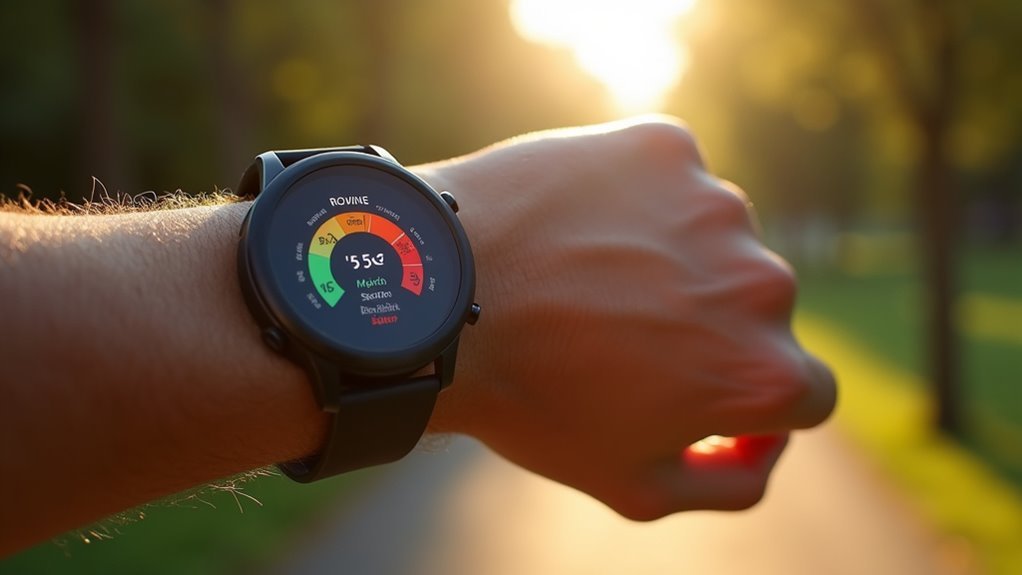You’ll maximize your marathon training success by tracking seven essential load metrics: weekly mileage (aim for 15-25 miles before formal training begins), heart rate variability to assess recovery status, session rating of perceived exertion using the 0-10 scale, acute-to-chronic workload ratios between 0.8-1.3 for ideal adaptation, power output measurement in watts for real-time effort management, excess post-exercise oxygen consumption for recovery insights, and sleep quality metrics with PSQI scores below 5. Master these data points to transform your training approach.
Training Volume and Weekly Mileage Tracking
Most marathon training programs center around weekly mileage as the foundation metric, with volumes ranging from 35 miles for beginners to over 140 miles for experienced runners.
You’ll want to track this data consistently using digital platforms like Strava or manual logs to monitor your progress effectively.
If you’re dealing with injury history, you should aim for 15-25 miles weekly before starting formal marathon training. The average training volume sits around 27 miles per week, though this varies based on your goals and experience level.
Build your weekly mileage to 15-25 miles before beginning marathon training, especially if you have previous injuries.
Higher volumes generally correlate with faster finish times, but you must increase mileage gradually to avoid overtraining. Research analyzing data from 150,000 everyday marathoners confirms this relationship between training volume and performance outcomes.
Elite runners often exceed 200km weekly, while midpack runners typically log 20-26 miles. Consistency in tracking helps you set realistic goals and maintain sustainable progress.
Heart Rate Variability for Recovery Assessment
You’ll need to measure HRV consistently using either a chest strap or wearable device that captures the time intervals between heartbeats.
The most common technique involves taking a short morning reading while lying still, typically measuring metrics like rMSSD or SDNN.
Once you’ve established your personal baseline over several weeks, you can interpret daily fluctuations to determine whether you’re recovered enough for hard training or need additional rest. Understanding average HRV levels for your specific age group is essential for effective interpretation of your personal readings.
HRV Measurement Techniques
While multiple devices can measure heart rate variability, the accuracy and practicality of each method varies considerably for marathon runners.
Smartphone camera apps offer accessible fingertip measurements for beginners, while chest strap monitors paired with ECG-based devices provide superior accuracy but require specialized equipment.
Wrist-worn wearables track overnight HRV but reflect previous day’s recovery rather than current readiness.
You’ll get the most reliable data by measuring immediately upon waking, sitting upright for 1-2 minutes after using the bathroom.
Avoid yawning, swallowing, or moving during recordings to prevent artifacts.
Maintain consistent timing and body position daily to build your individualized baseline. Remember that HRV measurements quantify the millisecond differences between consecutive heartbeats, reflecting your autonomic nervous system’s current state.
Morning measurements capture your autonomic nervous system’s shift, providing sensitive stress response data that’s particularly valuable for endurance training adjustments.
Recovery Status Interpretation
Interpreting your HRV data correctly determines whether you push forward with planned workouts or adjust your training load.
Focus on individual trends rather than absolute values, as your personal baseline matters more than standard thresholds. A 10-15% drop from your baseline signals compromised recovery, while consistent values indicate you’re ready for training.
Monitor these key recovery indicators:
- Morning HRV trends – Track 7-day rolling averages for reliable patterns
- Post-workout drops – Expect 15-25% reductions after hard sessions or long runs
- Recovery timeline – Allow 48-72 hours for HRV to return to baseline after marathons
- External stressors – Account for poor sleep, illness, or life stress affecting readings
Combine HRV with perceived recovery and sleep quality for thorough recovery assessment. Advanced training systems use personalized recovery models that incorporate your historical HRV data to create optimized training adaptations and reduce the risk of overtraining.
Session Rating of Perceived Exertion (sRPE)

You’ll find that sRPE provides a simple yet powerful way to quantify how hard your training sessions feel, typically using Borg’s CR-10 scale where you rate your overall exertion from 0 to 10.
By multiplying your sRPE rating by your session duration in minutes, you can calculate your training load in arbitrary units that reflect both intensity and volume.
This subjective measure captures your internal experience of effort, which often tells a different story than external metrics like pace or heart rate alone. The method requires proper familiarization with the RPE scale to ensure reliable and consistent measurements across your training sessions.
Understanding Srpe Scale
The session Rating of Perceived Exertion (sRPE) scale transforms how you measure training intensity by capturing your overall effort across an entire workout rather than moment-to-moment feelings.
Based on the Borg RPE scale, you’ll assign a single numerical rating immediately after completing your session, reflecting both physical and mental strain experienced throughout your run. This approach considers multiple physiological factors including breathing rate, heart rate, sweating, and muscle fatigue to provide a comprehensive assessment of your training load.
Here’s how to visualize the sRPE scale in action:
- Light recovery run: Rating 3-4, feeling like you could chat comfortably throughout
- Moderate tempo session: Rating 5-6, breathing controlled but purposeful effort required
- Hard interval workout: Rating 7-8, significant strain with labored breathing and muscle fatigue
- All-out race effort: Rating 9-10, maximum exertion leaving you completely depleted
You’ll multiply this rating by session duration to calculate training load.
Calculating Training Load
Calculating your training load with sRPE transforms subjective perception into actionable data through a straightforward multiplication: session RPE score × duration in minutes = training load.
This formula combines intensity perception with external load duration, giving you an integrated measurement of training stress that reflects both acute exertion and cumulative fatigue.
You’ll find sRPE particularly valuable because it captures fatigue accumulation that heart rate or lactate measurements might miss.
When you maintain consistent physiological markers but notice increasing sRPE scores over consecutive training days, you’re experiencing accumulated fatigue.
This sensitivity makes sRPE superior for detecting overreaching compared to objective metrics alone.
You can use this data immediately post-session to adjust subsequent workouts, ensuring ideal adaptation while preventing overtraining in your marathon preparation. The effectiveness of sRPE is demonstrated by its strong correlation with objective GPS-derived performance metrics, validating it as a reliable training monitoring tool.
Training Load Ratios and Acute-to-Chronic Workload
How do you know if you’re pushing too hard in your marathon training or not hard enough? The acute-to-chronic workload ratio (ACWR) gives you that answer. This metric compares your recent training stress against your long-term average, helping you maintain the sweet spot between progress and injury.
ACWR works by dividing your current week’s mileage by your four-week average. When this ratio spikes too high, you’re entering dangerous territory where injuries lurk. You can also calculate ACWR using total activity time instead of mileage for a more comprehensive view of your training load.
Here’s what different ACWR values mean for your training:
- 0.8-1.3: You’re in the ideal zone for adaptation and performance gains
- Above 1.5: Red flag territory – significant injury risk from sudden workload increases
- Below 0.8: You’re potentially undertraining and losing fitness
- Consistent monitoring: Track weekly to catch dangerous spikes before they sideline you
Power Output Measurement During Runs

While ACWR helps you monitor training volume changes, power output measurement takes your marathon preparation to the next level by quantifying the actual effort you’re generating with each step. Unlike pace, which fluctuates with terrain and fatigue, power provides immediate feedback on your true exertion in watts.
| Power Component | What It Measures | Training Benefit |
|---|---|---|
| Horizontal Power | Forward propulsion force | Speed and efficiency optimization |
| Form Power | Vertical/lateral movements | Running economy improvement |
| Total Power | Combined energy expenditure | Real-time effort management |
Devices like Stryd and Polar Vantage show excellent validity, correlating strongly with metabolic demand (r ≥ 0.91). You’ll maintain target intensity regardless of pace variations, enabling personalized pacing strategies essential for marathon energy management and performance prediction. This measurement system eliminates the need for separate devices, making power tracking particularly accessible for interval training and challenging hill runs.
Excess Post-Exercise Oxygen Consumption (EPOC)
Beyond tracking power output during your runs, understanding Excess Post-Exercise Oxygen Consumption (EPOC) reveals how your body continues burning calories and adapting long after you’ve finished training.
Your body’s calorie-burning engine doesn’t shut off when your workout ends—it keeps working hours after you stop running.
This “afterburn” effect occurs as your body works to restore oxygen levels, rebalance hormones, and repair muscle tissue damaged during intense efforts.
EPOC’s magnitude depends heavily on your workout intensity rather than duration alone. High-intensity intervals create the largest afterburn effect, keeping your metabolism elevated for up to five hours post-exercise. Your muscles must reach fatigue levels sufficient to trigger meaningful metabolic disruption for EPOC benefits to occur.
For marathon training optimization, monitor EPOC through these key indicators:
- Elevated heart rate lingering 30+ minutes after hard workouts
- Increased breathing rate during your cool-down period
- Body temperature remaining warm well after exercise completion
- Energy substrate depletion requiring post-workout fuel replenishment
Sleep Quality and Recovery Metrics
Sleep metrics provide the missing piece of your training puzzle that EPOC can’t reveal—how well your body actually recovers between sessions.
You’ll want to track your Pittsburgh Sleep Quality Index (PSQI), keeping scores below 5 for peak performance. Poor sleep quality directly correlates with fatigue and slower marathon times, while better sleep efficiency improves your running performance.
Monitor heart rate variability (HRV) and resting heart rate through wearable devices to assess recovery quality. Over 40% of endurance athletes experience excessive daytime sleepiness, which hinders training adaptation. Quality sleep reduces inflammation essential for recovery from high-intensity sessions.
Focus on managing training intensity and psychological stress, as both disrupt sleep patterns. Sleep also aids in tissue repair and muscle building, which are critical processes for marathon training adaptations.
You’ll need personalized monitoring since environmental factors, nutrition, and individual health conditions uniquely affect your sleep quality and recovery capacity.
Frequently Asked Questions
How Do Different Running Surfaces Affect Load Metric Accuracy and Training Adaptations?
Different running surfaces alter your load metric readings by changing impact forces and stride patterns. You’ll develop stronger biomechanical adaptations training on varied surfaces, but harder surfaces like concrete can reduce metric accuracy.
What Blood Lactate Levels Indicate Optimal Marathon Training Intensity Zones?
You’ll optimize marathon training by targeting Zone 2 lactate levels of 2.0-3.5 mmol/L for most runs, while occasionally approaching 4.0 mmol/L threshold efforts to improve your sustainable pace without excessive fatigue.
How Often Should Recreational Runners Test Their Maximum Heart Rate for Training?
You should test your maximum heart rate every 4-6 months as a recreational runner. This frequency allows you to adjust your training zones as your fitness level changes and guarantees you’re training at ideal intensities.
Which Wearable Devices Provide the Most Accurate Power Output Measurements for Runners?
You’ll find Stryd footpod and select Garmin watches with running dynamics provide the most accurate power estimates. However, running power remains an estimated metric, not direct measurement like cycling power meters offer.
How Do Weather Conditions Impact the Reliability of External Load Measurements?
Weather conditions directly affect your external load measurement accuracy. High temperatures, humidity, and solar exposure alter your device’s sensor performance and data collection reliability. You’ll notice inconsistent readings during extreme weather, requiring event-specific calibration models.
In Summary
You’ve now got seven powerful load metrics that’ll transform your marathon training. Start by tracking your weekly mileage and HRV, then gradually incorporate sRPE and training load ratios. Don’t overlook power output data and EPOC measurements—they’ll reveal insights you’re missing. Most importantly, prioritize sleep quality tracking since recovery drives adaptation. Use these metrics consistently, and you’ll train smarter, avoid overreaching, and cross that finish line stronger than ever.





Leave a Reply